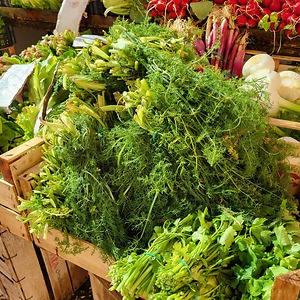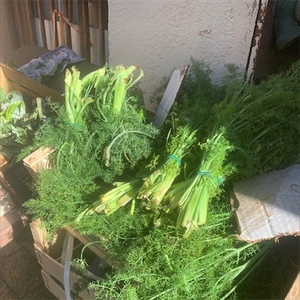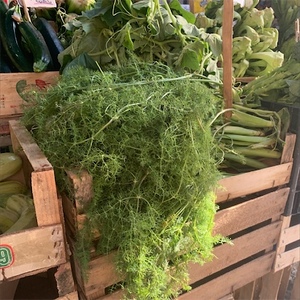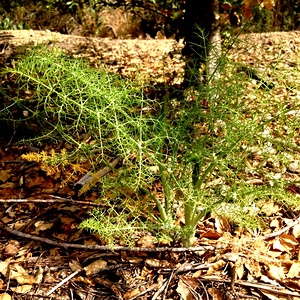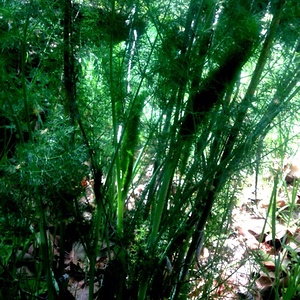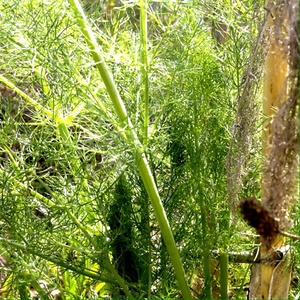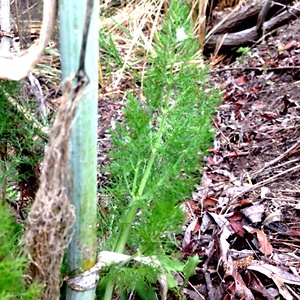


Foraged Wild Fennel
Estimated Inventory, lb : 0
Description/Taste
Wild Fennel is unmistakably recognized by its tall, wispy foliage. Its plant reaches heights ranging from 1.5 to 3 meters with leaves that extend up to 40 centimeters in length. Wild Fennel features a blend of feathery leaves and ribbed, hollow stems sprouting from its rooted base, known as the crown. From these rough textured stems, layered green branches and delicate foliage emerge. As the plant ages, it forms an umbrella-shaped cluster of vibrant yellow flowers, which eventually give way to seeds. These seeds shift from green-brown to a dark brown hue as they mature and dry, characterized by their small, elongated, and slightly curved shape. Wild Fennel is renowned for its sweet yet potent licorice-like scent and flavor, complemented by mint and citrus undertones. Its leaves and stems offer a mild, sweet flavor reminiscent of anise, whereas its seeds deliver a more intense anise taste.
Seasons/Availability
Wild Fennel regrows each spring but can be found year-round in temperate climates.
Current Facts
Wild Fennel, botanically known as Foeniculum vulgare, is classified as an herbaceous perennial herb that produces plants every year. It is a member of the Umbelliferae family, which also includes dill, anise, cumin, and caraway. Fennel plants produce hermaphrodite flowers with both male and female parts. Both Wild and Domesticated Fennel have anise-like culinary properties. This is due to the high potency of the volatile compounds anethole and estragole. Herbs such as basil, mint, celery, and chervil share the same compounds. What sets Wild Fennel apart from domestic fennel is its lack of thick, round, bulbous vegetables, which actually originate from a different plant known as Florence fennel. While it possesses feathered stalks akin to its wild counterpart, Florence fennel is shorter and significantly milder.
Nutritional Value
Wild Fennel is rich in fiber, vitamin C, folate, and potassium, supporting digestion and immune health. It has carminative, antispasmodic, diuretic, detoxifying, and galactogenic properties, allowing it to help absorb and eliminate gas and enhance detoxification when combined with herbs like dandelion, milk thistle, and artichoke. Wild Fennel infusions address gastrointestinal issues by encouraging intestinal peristalsis and mitigating inflammation and spasms. Its expectorant qualities aid in clearing phlegm, thereby improving breathing and promoting restful sleep. Wild Fennel's medicinal use, especially its seeds, has been valued for its soothing effects on digestive disorders and as a remedy for infantile colic, often consumed as a calming tea.
Applications
Every part of the Wild Fennel plant, from the crown to the flower to the seed, is edible. It can be enjoyed raw, braised, caramelized, or roasted and pureed into soups and sauces, with its anise flavor becoming subtler and less pronounced upon cooking. Wild Fennel complements seafood dishes, particularly with crustaceans and bivalves like scallops and oysters, and pairs well on top of salads. It's also ideal for enriching potato dishes, braising with chicken, incorporating savory pastries, or roasting alongside vegetables. Utilized across Italian, Indian, Middle Eastern, French, Greek, and Chinese cuisines, Wild Fennel can be paired with leeks, garlic, shallots, root vegetables, artichokes, bacon, chickpeas, cream, chicories, tomatoes, and fresh cheeses such as burrata and feta. It also goes well with herbs like basil, mint, tarragon, and parsley, as well as spices like caraway, cumin, and mustard seed. For storage, Wild Fennel can be kept in a plastic bag or container in the refrigerator for up to a week or dried and frozen for several months.
Ethnic/Cultural Info
In Greece, Wild Fennel is known as "maratho," and it is believed that Marathon, the historic area south of Athens where the Greeks achieved a significant victory against the Persian army in 490 BCE, was named for its plentiful fennel fields. The legend of Pheidippides, who ran 42 kilometers from Marathon to Athens to declare the Greeks' triumph, gave birth to the concept of the marathon race. In Southern France, Wild Fennel's fresh stalks and fronds are traditionally used to create a fragrant bed for grilling fish, and a few stalks are considered vital for flavoring fish soup and bouillabaisse. In India, it forms a part of mukhwas, a colorful after-meal snack designed to refresh the palate and aid digestion.
Geography/History
Wild Fennel, originally from the Mediterranean region stretching from Turkey to Spain and Morocco, has spread to temperate climates worldwide. It thrives in various environments, including grasslands, farmlands, coastal areas, and gardens, particularly favoring disturbed grounds such as roadside verges, waste grounds, and sand dunes. Its global dispersion is often attributed to the Romans, who valued it for culinary and medicinal uses, leading to its widespread naturalization. Today, it is mainly found in Central and Southern England and along the Welsh coast. Known for its invasive qualities, Wild Fennel can reproduce through both its root crown and seeds, making it an invasive species in many parts of North and South America, South Africa, Oceania, and the British Isles. Despite its aggressive growth, Wild Fennel is still foraged in regions where it is abundant and sometimes available in local markets or specialty stores, especially in areas where it forms a traditional part of the cuisine.
Recipe Ideas
Recipes that include Foraged Wild Fennel. One



